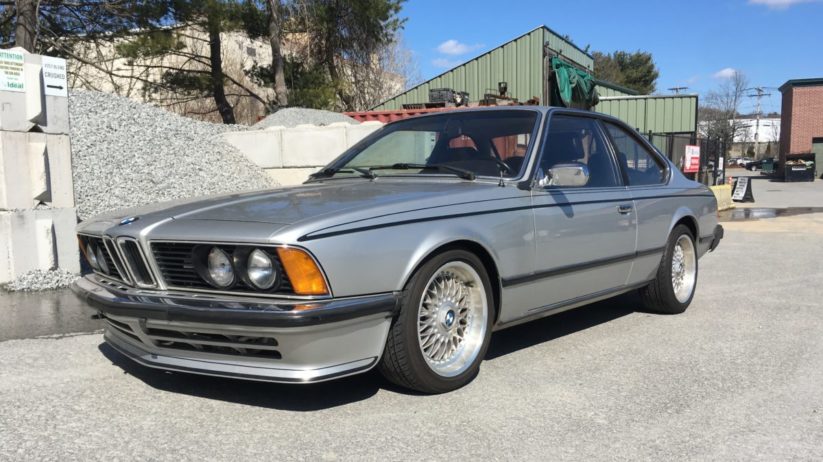Over 30 years ago—in the April 1987 Roundel, to be exact—I penned an article titled “How To Buy A Used BMW And Not Get Burned.” In it, I described the things mechanics do when they look at a car—you know, jacking up the nose and checking for play in the front end, bouncing the car at all four corners to test the struts and shocks, etc.
Near the end of the piece, I said, “It may all sound overwhelming, but you’re naturally aware of most of these things when you drive any car: bad brakes, loud exhausts, hopelessly maladjusted fuel injection, and oxcart-like handling generally announce their presence quite plainly. It’s reassuring; even if you know absolutely nothing about cars, you can still take them for test drives and weed out most of the dogs.”
Regarding the oxcart-like handling part, well, funny story….
I’ve written quite a bit the past year about Sharkie, my Euro ’79 635CSi. Last spring and summer, I wrote, I believe, eleven pieces about the a/c retrofit into the car. A few weeks ago, I described replacing the leaky gas tank, swapping the differential for a shorter one that’ll give the car a little more scoot, and replacing the shifter bushings to tighten up the linkage.
As it happens, those repairs all occurred after, not before, I drove the car to Southeast Sharkfest in 2016. Since that trip, the recent repairs notwithstanding, I’ve really driven the car very little. Some of that has simply been due to the weather. It’s been a cold spring here in the Northeast, with winter seeming to reach out from the grave and spatter snow long after polite agreement would indicate that it should stop. So it took a while for me to take Sharkey for a proper drive after the gas tank/differential/shifter-bushings troika.
When I did take it out, its ride felt, well, oxcart-like. Now, it may have been like this for a while—possibly even for the whole time I’ve owned it. It’s never been a comfortable car to drive. If this sounds like shocking negligence on my part, in my defense, with the car’s list of immediate needs when I bought it, the necessary prophylactic sort-out when I took it to Sharkfest two years ago, and the recent repairs, I just wasn’t paying attention to the suspension. As long as you’re not tracking a car or driving it off-road, shocks and struts can be in astonishingly bad condition—completely blown or completely seized—and have surprisingly little effect if the car is lightly driven at slow-to-moderate speeds on smooth roads.
So when I did drive Sharkey last week, its jarring seesaw-like ride didn’t register as, “Maybe this thing has seized front struts.” It was more like, “Damn this thing feels stiff in the front. I wonder what springs and struts the previous owner installed in the front, and if they’re matched to the rear.”
The epiphany that I simply had seized—or seizing—struts happened in a funny way. I stopped into a hardware store to buy some of that special heavy-duty Velcro that’s used to attach tollway transponders to the windshield (I have two transponders that I move around among the vintage cars, and needed the compatible Velcro to hold one of them on Sharkie’s windshield). As I left the hardware store and drove around the back to the exit, I noticed that there were large bins of gravel for landscaping. I had a flashback to a Roundel cover that Klaus Schnitzer shot 30 years ago of an M6 in a gravel pit. (For a while in the late 1980s, Klaus shot a lot of cars in gravel pits. If memory serves me correctly, there was a gravel pit near his house.) I positioned Sharkie in front of the bins of gravel and took a few shots with my phone. Klaus I’m not, but with its Euro bumpers and black stripes, Sharkie is a pretty photogenic car in almost any circumstance.
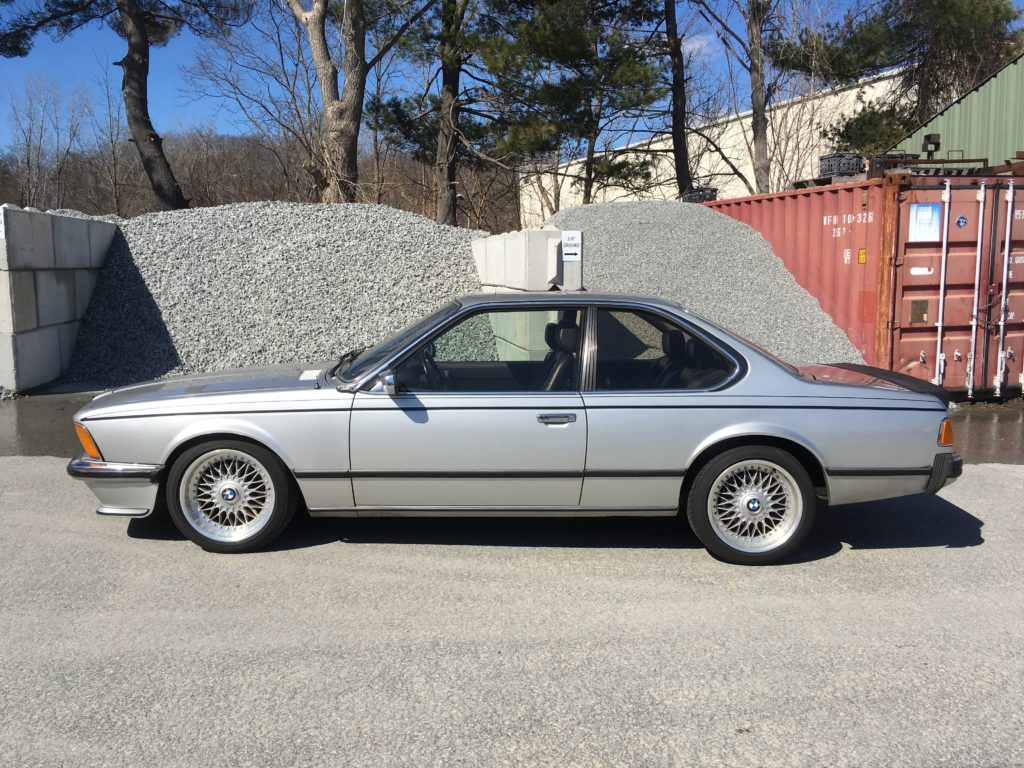
Sharkie in front of gravel: My homage to a bunch of Klaus Schnitzer photographs of BMWs in gravel pits.
It was as I re-positioned the car and walked around it that I saw that the right side of the nose was several inches lower than the left. In fact, the right front tire was tucked up under the fender, as if the car had been bagged and stanced.
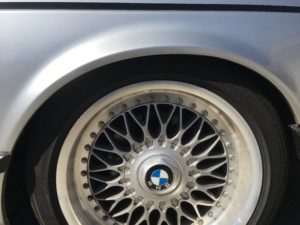
Fender sagging onto right front wheel. Ruh roh.
My first thought was that I’d broken a spring (something you never think of until you’ve broken a spring, and then are forever afraid of it happening again). There wasn’t enough room to see, or to get my hand up underneath to check. I was only a few miles from my house, so I decided to nurse the car home. When I turned out of the driveway at the hardware store, I heard Sharkie’s right front tire scrape alarmingly. I thought, sheesh, be careful; you’ll feel like a total idiot if you rip up the front fender.
When I got home, I carefully backed the car into the driveway and prepared to put it up on the mid-rise lift. But then I noticed that the sag in the right front was gone, so it was unlikely that the culprit was a broken spring.
I then did what I’m pretty sure I did when I bought the car, but can’t swear to it: I walked around to all four corners and bounced them in turn. For the uninitiated, this is the classic test for blown or seized shocks and struts. When you push down sharply above each wheel, the car should give, and then rebound smoothly. If it doesn’t give, the shock or strut at that wheel is likely seized. If it continues to bounce up and down, that shock or strut is likely blown. This time-worn test still works well… except on cars with very stiff suspensions. For example, I can barely budge the corners of my Z3 M coupe. It also can occasionally be misleading on cars whose suspensions and shocks are so cushy that they give as soon as you look at them.
On Sharkie, the test was pretty definitive. The rears felt fine, but both fronts barely budged when pushed down. That could be due to the front-suspension components being badly mismatched from the rears, but combined with the fact that the right front had been drooping by several inches and now was not, the diagnosis was clear: seizing front struts. When I posted this on Facebook, someone said, “But now you get to install Bilsteins, right?” Ah, my readers know me too well.
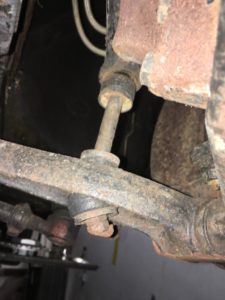
The bent sway bar attachment link.
So up the car went on the mid-rise lift. I began pulling out both front strut assemblies. I undid both calipers and swung them off to the side. I then disconnected the sway-bar links from both sides; while this is not strictly necessary, it makes it easier to independently move around each steering knuckle and align its holes with those on the bottom of the strut housing during re-installation.
Unfortunately, I found that the link on the left side had been through an encounter with a stationary object that bent it up, making it impossible to undo the nuts at the bottom; but after some judicious trimming with the Dremel tool, I was able to detach it.
I was a bit surprised to find that there was no safety wire in the bolts holding the steering knuckles to the bottoms of the struts, but then I saw why: The wire had been cut, and the remaining pieces were rusted in place in their holes. Sharkie has about 220,000 miles on it. Although it’s a nearly rust-free car, that’s still a lot of exposure. Even using an impact wrench to take out the bolts, they groaned with each twist, but out they came, allowing me to separate the bottom of the struts from the steering knuckles.
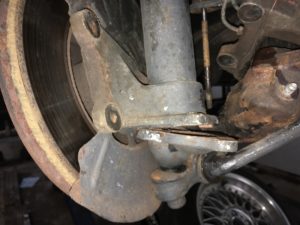
The steering knuckle separated from the bottom of the strut housing.
In fairly short order, I had both strut assemblies lying prostrate on the garage floor. I put a spring compressor on each spring, put the impact wrench on the big gland nuts at the tops of the struts, spun them off, and pulled off the strut tower bushings, springs, and perch rubber. I spun the bearings in each of the bushings by hand, and found that the one on the right was obviously bound up. I made a note to order a new pair of bushings. I also noted that one of the four pieces of perch rubber was torn in two, and added that to the mental parts list.
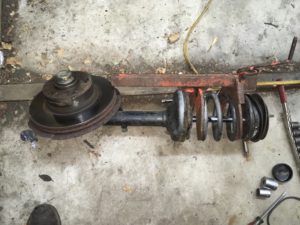
Compressor on the spring and…
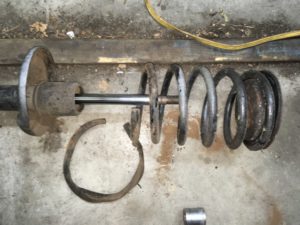
…spring pulled off the strut housing.
It was then time to pull the strut cartridges from their housings. This requires loosening the collar nuts. In old cars, these rarely come off without a fight. My tried-and-true technique is copious quantities of heat on the collar nut with a MAPP gas or, if necessary, oxyacetylene torch (and goggles in case the fluid or gas in the strut decides to stage a dramatic escape), touching a Goodson’s Oil Gallery Wax Stick to the threads, and then using two big pipe wrenches, one loosening the collar nut, and the other holding the strut housing still. Note that this does in fact mar the body of the strut housing, but my cars are not concours entries, so I don’t care. (The non-marring way to do it is to mount the wheel and tire back on the hub, turn the assembled mess over so that the tire is lying flat on the ground, and stand on the back of the wheel and tire.)
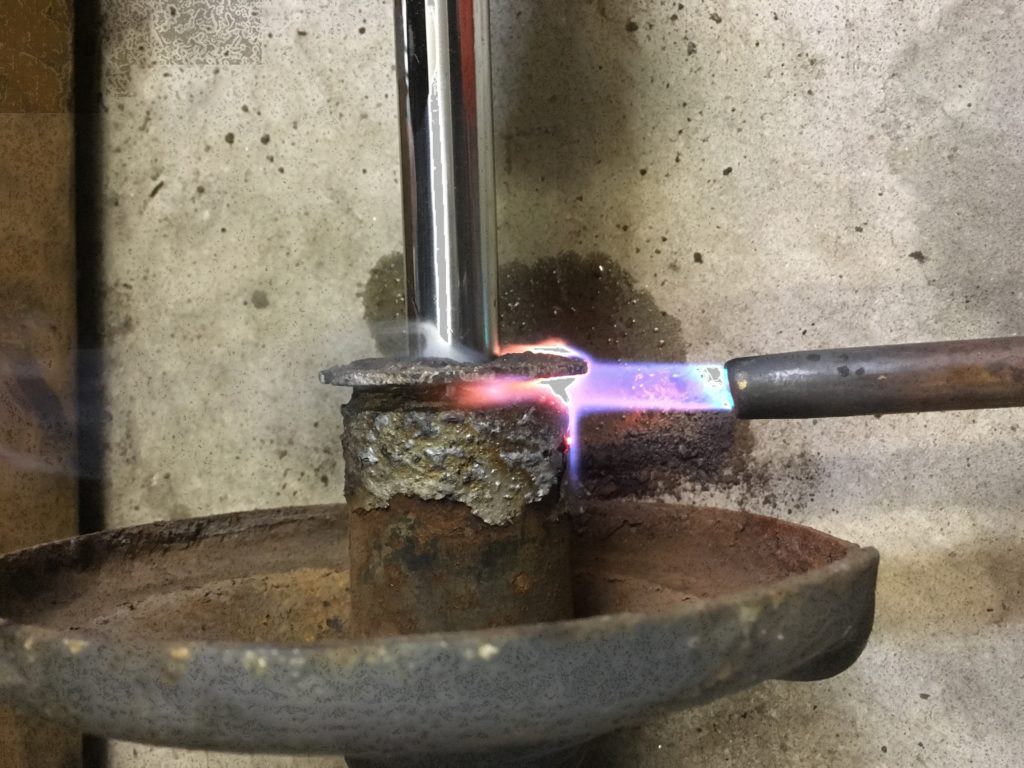
Heat can’t be beat. But wear goggles.
One sore back and shoulder later, I successfully extracted two yellow Boge strut cartridges. Neither was completely seized; both were easily movable in the down direction but were very difficult to pull back up. The post-mortem certainly fit the symptoms well enough.
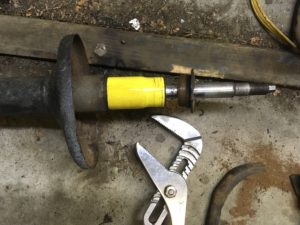
Extracting the ancient Boge strut cartridge.
I then went upstairs and sat down at the computer to order parts. When I need Bilsteins, I usually order from Roundel advertiser Bavarian Autosport. Their Bilstein prices usually beat everyone, and they’re just north of me in New Hampshire, so the parts are delivered in a day or two. I was thrilled when I saw that their price on Bilstein B6 HDs for the ’79 635CSi were even lower than I expected—just $115 per side, shipped free. I thanked my good luck, selected Quantity Two, and put them in the cart.
Oh—I need strut-tower bushings too. Right. I searched for them at BavAuto, and nearly fell off my chair when I saw the price: $290 per side. That’s more for each bushing than for the pair of Bilsteins.
BavAuto, like many parts websites, often gives you options of OEM versus aftermarket parts, but the only strut-tower bushings they were showing were OEM. Okay, I thought, I’ll just buy the Bilsteins and search elsewhere for the bushings. Unfortunately, as I began to check out of BavAuto, I saw the message that they only had one Bilstein strut in stock. Damn. “Out of stock” can mean “three days until we get more from the warehouse” or “we need to get order the part directly from the manufacturer” or “they’re on backorder, time frame unknown.” I wasn’t going to submit the order without knowing which it was.
There was nothing to do but go to bed and call Bavarian in the morning and find out what the impact was of the “out of stock” message. Sore from throwing my 59-year-old body against the struts, I was done for the evening anyway. I’d deal with ordering the struts and bushings on the morrow.
The high cost of OEM bushings notwithstanding, I was certain that in the morning my parts-sleuthing skills would unearth an aftermarket supplier. I popped an Advil and went to bed happy that I was going to get out of this strut issue without losing my shirt. Plus, I’d removed both strut assemblies and gotten both strut cartridges out of a nearly 40-year-old car with 220,000 miles on it, with the only mechanical roadblock being having to deal with a bent-up sway bar attachment link. There were none of the stripped threads or broken bolts that drag repair work on an old car to a standstill and cause grown men to weep alone in their garages.
I dozed off, thinking lovely thoughts of what was shaping up to be a cost-contained and surprisingly drama-free repair of Sharkie’s seized struts.
It was a nice dream—while it lasted.—Rob Siegel
Got a question for Rob Siegel, the Hack Mechanic? You can find him in the BMW CCA Forums here!
Rob’s new book, Ran When Parked: How I Resurrected a Decade-Dead 1972 BMW 2002tii and Road-Tripped it a Thousand Miles Back Home, and How You Can, Too, is now available on Amazon. Or you can order personally inscribed copies through Rob’s website: www.robsiegel.com. His new book, Just Needs a Recharge: The Hack MechanicTM Guide to Vintage Air Conditioning, will be out in the spring.

